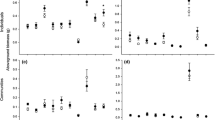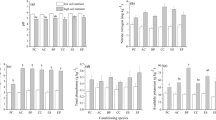Abstract
Competitive ability, the ability to generate legacy effects, and the potential to benefit from priority, individually or interactively, are traits that may increase the invasive potential of plants. In this project we examine these three traits in three invasive species (Agropyron cristatum, Bromus tectorum, and Taeniatherum caput-medusae). Specifically in this study, we examine competitive effects of these invasive species, the ability of these invasive species to generate legacy effects (as plant–soil feedback), and the potential of these three species benefit from priority (being sown concurrently, 30 days before, and 30 days after the restoration species) in a greenhouse study using field collected soil. Our results suggest that all three invasive species can benefit from priority and all three have high competitive ability. However, only A. cristatum benefited from legacy effects of plant–soil feedback.



Similar content being viewed by others
References
Armas C, Ordiales R, Pugnaire FI (2004) Measuring plant interactions: a new comparative index. Ecology 85:2682–2686
Baker H (1974) The evolution of weeds. Annu Rev Ecol Syst 5:1–24
Bever JD, Dickie IA, Facelli E et al (2010) Rooting theories of plant community ecology in microbial interactions. Trends Ecol Evol 25:468–478
Bilbrough CJ, Caldwell MM (1997) Exploitation of springtime ephemeral N pulses by six great basin plant species. Ecology 78:231–243
Blank RR (2010) Intraspecific and interspecific pair-wise seedling competition between exotic annual grasses and native perennials: plant–soil relationships. Plant Soil 326:331–343
Brinkman EP, Van der Putten WH, Bakker EJ et al (2010) Plant–soil feedback: experimental approaches, statistical analyses and ecological interpretations. J Ecol 98:1063–1073
Clausnitzer DW, Borman MM, Johnson DE (1999) Competition between Elymus elymoides and Taeniatherum caput-medusae. Weed Sci 47:720–728
Cuddington K (2011) Legacy effects: the persistent impact of ecological interactions. Biol Theory 6:203–210
Cuddington K, Hastings A (2004) Invasive engineers. Ecol Model 178:335–347
Dante SK, Schamp BS, Aarssen LW (2013) Evidence of deterministic assembly according to flowering time in an old-field plant community. Funct Ecol 27:555–564
Davies KW, Svejcar TJ (2008) Comparison of medusahead-invaded and noninvaded Wyoming big sagebrush steppe in southeastern Oregon. Rangel Ecol Manag 61:623–629
Davies KW, Boyd C, Nafus A (2013) Restoring the sagebrush component in crested wheatgrass-dominated communities. Rangel Ecol Manag 66(4):472–478
DeFalco LA, Fernandez GCJ, Nowak RS (2007) Variation in the establishment of a non-native annual grass influences competitive interactions with Mojave Desert perennials. Biol Invasions 9:293–307
Dickson TL, Hopwood JL, Wilsey BJ (2012) Do priority effects benefit invasive plants more than native plants? An experiment with six grassland species. Biol Invasions 14:2617–2624
Elton C (1958) The ecology of invasions by animals and plants. University of Chicago Press, Chicago
Francis MG, Pyke DA (1996) Crested wheatgrass cheatgrass seedling competition in a mixed-density design. J Range Manag 49:432–438
Goergen EM, Leger EA, Espeland EK (2011) Native perennial grasses show evolutionary response to Bromus tectorum (Cheatgrass) invasion. PLoS One 6:e18145
Goldberg DE, Landa K (1991) Competitive effect and response: hierarchies and correlated traits in the early stages of competition. J Ecol 79:1013–1030
Grman E, Suding KN (2010) Within-year soil legacies contribute to strong priority effects of exotics on native California grassland communities. Restor Ecol 18:664–670
Hart SP, Marshall DJ (2012) Advantages and disadvantages of interference-competitive ability and resource-use efficiency when invading established communities. Oikos 121:396–402
Humphrey LD, Schupp EW (2004) Competition as a barrier to establishment of a native perennial grass (Elymus elymoides) in alien annual grass (Bromus tectorum) communities. J Arid Environ 58:405–422
Jordan NR, Larson DL, Huerd SC (2008) Soil modification by invasive plants: effects on native and invasive species of mixed-grass prairies. Biol Invasions 10:177–190
Jordan NR, Aldrich Wolfe L, Huerd SC et al (2012) Soil-occupancy effects of invasive and native grassland plant species on composition and diversity of mycorrhizal associations. Invasive Plant Sci Manag 5:494–505
Jurand BS, Abella SR, Suazo AA (2013) Soil seed bank longevity of the exotic annual grass Bromus rubens in the Mojave Desert, USA. J Arid Environ 94:68–75
Kueffer C, Pyšek P, Richardson DM (2013) Integrative invasion science: model systems, multi-site studies, focused meta-analysis and invasion syndromes. New Phytol 200:615–633
Kulmatiski A, Beard KH, Stevens JR et al (2008) Plant–soil feedbacks: a meta-analytical review. Ecol Lett 11:980–992
Mack RN, Pyke DA (1983) The demography of Bromus tectorum: variation in time and space. J Ecol 71:69–93
Meisner A, de Boer W, Cornelissen JHC et al (2012) Reciprocal effects of litter from exotic and congeneric native plant species via soil nutrients. PLoS One 7:8
Moles AT, Flores-Moreno H, Bonser SP et al (2012) Invasions: the trail behind, the path ahead, and a test of a disturbing idea. J Ecol 100:116–127
Morris LR, Monaco TA, Sheley RL (2011) Land-use legacies and vegetation recovery 90 years after cultivation in great basin sagebrush ecosystems. Rangel Ecol Manag 64:488–497
Perkins LB, Nowak RS (2013a) Native and non-native grasses generate common types of plant–soil feedbacks by altering soil nutrients and microbial communities. Oikos 122:199–208
Perkins LB, Nowak RS (2013b) Soil conditioning and plant–soil feedbacks affect competitive relationships between native and invasive grasses. Plant Ecol 213:1337–1344
Perkins LB, Nowak RS (2013c) Invasion syndromes: hypotheses on relationships among invasive species attributes and characteristics of invaded sites. J Arid Land 5:275–283
Peterson EB (2005) Estimating cover of an invasive grass (Bromus tectorum) using tobit regression and phenology derived from two dates of Landsat ETM plus data. Int J Remote Sens 26:2491–2507
Radford IJ (2013) Fluctuating resources, disturbance and plant strategies: diverse mechanisms underlying plant invasions. J Arid Land 5:284–297
Radford IJ, Dickinson KJM, Lord JM (2009) Does disturbance, competition or resource limitation underlie Hieracium lepidulum invasion in New Zealand? Mechanisms of establishment and persistence, and functional differentiation among invasive and native species. Aust Ecol 35:282–293
Schwinning S, Weiner J (1998) Mechanisms determining the degree of size asymmetry in competition among plants. Oecologia 113:447–455
Stewart G, Hull AC (1949) Cheatgrass (Bromus tectorum L.): an ecologic intruder in Southern Idaho. Ecology 30:58–74
Tanner RA, Gange AC (2013) The impact of two non-native plant species on native flora performance: potential implications for habitat restoration. Plant Ecol 214:423–432
Vaccaro LE, Bedford BL, Johnston CA (2009) Litter accumulation promotes dominance of invasive species of cattails (Typha spp.) in Lake Ontario wetlands. Wetlands 29:1036–1048
Vila M, Weiner J (2004) Are invasive plant species better competitors than native plant species? Evidence from pair-wise experiments. Oikos 105:229–238
Wainwright CE, Wolkovich EM, Cleland EE (2012) Seasonal priority effects: implications for invasion and restoration in a semi-arid system. J Appl Ecol 49:234–241
Wolkovich EM, Cleland EE (2011) The phenology of plant invasions: a community ecology perspective. Front Ecol Environ 9:287–294
Young JA, Evans RA (1973) Downy brome: intruder in the plant succession of big sagebrush communities in the Great Basin. J Range Manag 26:410–415
Acknowledgments
This work was supported by the South Dakota Agricultural Experiment Station and the Nevada Agricultural Experiment Station. The manuscript was improved by comments and suggestions of anonymous reviewers and Dr. KC Jensen.
Author information
Authors and Affiliations
Corresponding author
Rights and permissions
About this article
Cite this article
Perkins, L.B., Hatfield, G. Competition, legacy, and priority and the success of three invasive species. Biol Invasions 16, 2543–2550 (2014). https://doi.org/10.1007/s10530-014-0684-3
Received:
Accepted:
Published:
Issue Date:
DOI: https://doi.org/10.1007/s10530-014-0684-3




